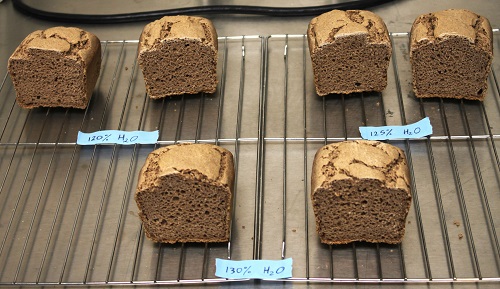USA
April 24, 2023
Sorghum bran, often a low-cost byproduct of sorghum milling, can enhance gluten-free bread's nutritional value without compromising its flavor, according to a study published in the Journal of Food Science.
While gluten-free foods are in demand to meet consumers' medical needs and dietary preferences, these foods sometimes are deficient in nutrients and lack taste and texture that appeals to consumers. In gluten-free bread, wheat flour is typically replaced with refined flour and starches from other sources. Adding dietary fiber, a carbohydrate found in whole grains that has important health benefits, to gluten-free bread can lead to a hard texture and more rapid staling.
To find solutions to these challenges, U.S. Department of Agriculture (USDA)'s Agricultural Research Service (ARS) researchers studied sumac sorghum bran, classified as a brown tannin-containing variety with antioxidant properties and dietary fiber, as a possible substitute for wheat flour in gluten-free bread.
"In our study, we used optimization models to create a gluten-free bread with enhanced dietary fiber while preserving other desirable bread attributes such as color, texture, and flavor," said Ryan Ardoin, research food technologist at ARS's Food Processing and Sensory Quality Research Unit in New Orleans. "This meant finding the optimal amount of sumac sorghum bran to use in the bread to get the nutritional benefits without comprising taste and texture."
 ARS researchers baked bread loaves containing sumac sorghum bran during the research study. (Photo by Brennan Smith, D5098-1)
ARS researchers baked bread loaves containing sumac sorghum bran during the research study. (Photo by Brennan Smith, D5098-1)
Ardoin and Brennan Smith along with researchers Fadi Aramouni and Scott Bean from ARS's Grain Quality and Structure Research Unit in Manhattan, Kansas, conducted taste tests and asked consumers to rate different breads with and without the sorghum bran.
"We found that people liked the gluten-free bread that contains 14.2% sumac sorghum bran and would be just as willing to buy this bread," said Ardoin. "There was no difference in perceived bitterness found between the bread with and without the sorghum bran."
Ardoin, whose work involves novel food development and sensory evaluation, said making foods appealing to the senses is important. People seek gluten-free food options and prefer foods with a similar flavor and texture as their gluten-containing counterparts.
According to the National Institutes of Health (NIH), about 2 million people in the United States have celiac disease, an autoimmune condition, and must avoid dietary gluten, a protein found in wheat, rye, and barley. Additionally, over 20% of U.S. consumers purchase gluten-free products without a medical reason.
"The potential health benefits provided by tannin-containing sorghum bran in gluten-free foods can benefit consumers who must avoid gluten as well as those seeking other food options," said Ardoin.